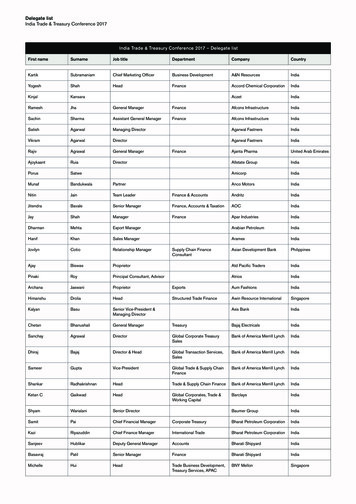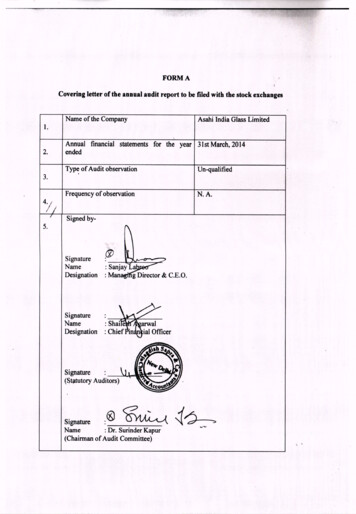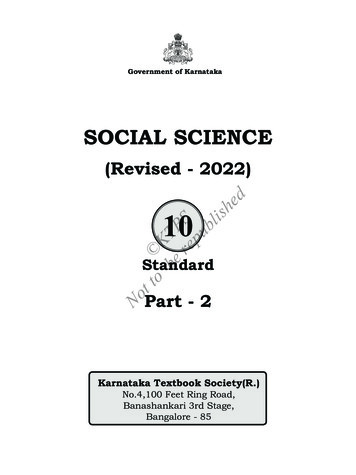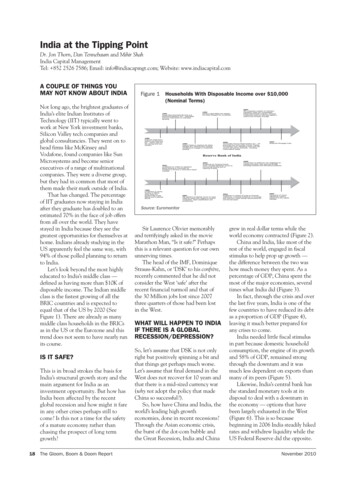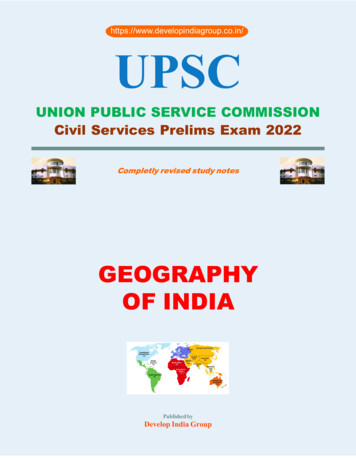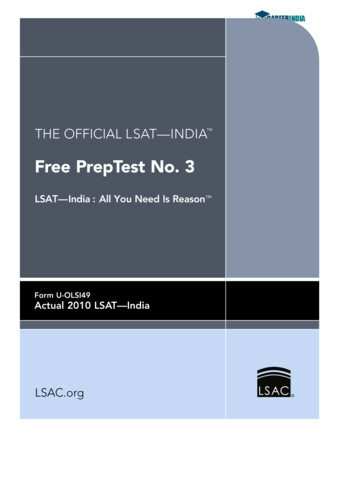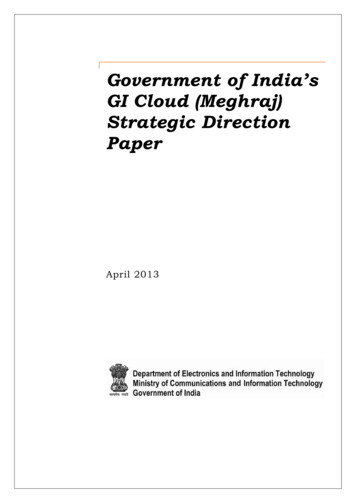
Transcription
Government of India’sGI Cloud (Meghraj)Strategic DirectionPaperApril 2013
GI Cloud (Meghraj) Strategic Direction PaperAcknowledgementThis document has been prepared by Department of Electronics and IT (DeitY) with inputsfrom the GI Cloud Task Force. We would like to thank all the Task Force members for theirvaluable suggestions and support. We would also like to thank the PwC Programme Officeand others who have directly or indirectly contributed to this report.In particular, we would like to thank CISCO IBSG, industry associations namelyNASSCOM, USIBC and BSA who shared their experiences and provided necessary inputsin finalisation of this document.Page 2 of 32
GI Cloud (Meghraj) Strategic Direction PaperTable of Contents1. Foreword. 42. Purpose of this paper . 53. The need for GI Cloud . 64. Definition of cloud computing adopted for GI Cloud .75. Key drivers and potential benefits of GI Cloud . 86. Potential risks and issues of GI Cloud .107. Vision . 148. Policy . 149. Objective . 1510.GI Cloud Strategy . 1511.Annexure I: Key takeaways from international government cloud initiatives . 2312.Annexure II: Gartner Hype Cycle for Cloud Computing 2012 . 2413.Annexure III: NIST Definition of Cloud Computing . 2514.Annexure IV: GI Cloud Task Force Constitution . 2815.Glossary . 2916.References. 32Page 3 of 32
GI Cloud (Meghraj) Strategic Direction Paper1. ForewordCloud computing has the potential to transform the way IT is consumed andmanaged, resulting in improved cost efficiencies, accelerated innovation, faster timeto-market, and the ability to scale applications on demand.According to Gartner it is clear that there is a major shift towards the cloud modelleading to substantial benefits. The shape of the cloud is emerging, and it isdeveloping rapidly both conceptually as well as in reality.However, the legal,contractual, economic and security aspects of cloud computing are evolving and areyet to attain maturity.Across the world, governments in the US, the UK, the European Union, Australiaand Singapore see cloud services as an opportunity to improve government servicedelivery outcomes by eliminating redundancy, increasing agility and providinginformation and communication technology (ICT) services at a cheaper cost.The Government of India has implemented a number of ICT initiatives under theNational e-Governance Plan (NeGP), including creation of ICT infrastructure both atthe centre and state levels. The infrastructure thus created will provide the basis foradoption of cloud computing for the government with the objective of makingoptimum use of existing infrastructure, re-use of applications, efficient servicedelivery to the citizens and increasing the number of e-transactions in the country,thus helping achieve the ultimate goal of NeGP.To harness the benefits of cloud, Department of Electronics and IT (DeitY) ofGovernment of India has embarked upon an ambitious project termed as ‘GI Cloud’.The ‘GI Cloud’ is the Government of India’s cloud computing environment that willbe used by government departments and agencies at the centre and states. In otherwords, it will enable the government to leverage cloud computing for effectivedelivery of e-services.This initiative will comprise the formation and implementation of a cloud computingenvironment at a national level that will act as a common repository of cloud-basedinfrastructure resources and applications available on a sharable basis. This will bepossible by creating seamlessly operated infrastructure across the country by interconnecting the components of network and data centres while comprehensivelyPage 4 of 32
GI Cloud (Meghraj) Strategic Direction Paperaddressing all security related aspects. This will, inter-alia, enable Rapid Replicationof the successfully implemented applications across the country.While the GI Cloud initiative will focus on setting up an eco-system for cloudadoption by the Government, leveraging the existing infrastructure, DeitY hasestablished a Working Group headed by Shri Kris. Gopalakrishnan to recommendan overall Policy framework for cloud services in the country.2. Purpose of this paperThis paper aims to provide a strategic direction towards establishing andimplementing the GI Cloud and an approach for its adoption by the government. Thegovernment ICT infrastructure components that are already in place would act asthe building blocks for the envisaged GI Cloud. It identifies the potential risks andchallenges of GI Cloud, and its key drivers and benefits.This paper states the Government of India’s vision and policy for its adoption ofcloud computing. Finally, it provides a high-level adoption approach for establishingand implementing the GI Cloud.The intended audience for this paper are the government departments at centre andstates and industry. This paper is to be used by the government departments andindustry to understand the direction of the government towards adoption of cloudand different definitions, models and services being acknowledged bythegovernment.A ‘GI Cloud Adoption and Implementation Roadmap’ will also be published providinga detailed implementation plan of the GI Cloud initiative.Page 5 of 32
GI Cloud (Meghraj) Strategic Direction Paper3. The need for GI CloudThe National e-Governance Plan (NeGP) has led to the creation of common ICTinfrastructure such as State Wide Area Networks (SWANs), State Data Centres(SDCs) and Common Service Centres (CSCs) as well as development of guidelinesand standards to ensure interoperability, standardisation and integration of variousservices to provide a single face of the government to the people. The progress ofNeGP and other national initiatives like National Data Centres (NDCs), NICNET,National Knowledge Network (NKN) and National Optical Fibre Network (NoFN)highlight the fact that core ICT infrastructure has been rolled out and there isconsiderable reach in terms of connectivity both at the national and state level.The GI Cloud is envisaged to be established initially on national and state datacentre assets (adapted for the cloud through virtualisation) and connected throughexisting network infrastructure such as the SWANs, NKN, as well as the ntsecurityrelatedconsiderations, government may also engage the services of private cloud providers.The GI Cloud will provide services to government departments, citizens andbusinesses through internet as well as mobile connectivity. In addition toaccelerating the delivery of e-services to citizens and businesses , the government’scloud-based service delivery platform will also support a number of other objectivesincluding increased standardisation, interoperability and integration, a movetowards an opex model, the pooling of scarce, under-utilised resources and thespread of best practices. It will also support on-going cost effectiveness andmanageability.With cloud computing there is considerable scope of speeding up the developmentand roll out of e-Governance applications, enhancing agility in customising anddeploying ICT to meet specific business needs, while at the same time increasinggovernment ICT efficiency (through re-use and economies of scale).For realizing this vision and to establish the envisaged cloud computing platform, awell-defined adoption strategy and roadmap are critical.Page 6 of 32
GI Cloud (Meghraj) Strategic Direction Paper4. Definition of cloud computing adopted forGI CloudThe US National Institute of Standards and Technology’s (NIST) definition of cloudcomputing is the most widely adopted one and has been adopted by the Governmentof India for GI Cloud.It states the following:Cloud computing is a model for enabling ubiquitous, convenient, on-demandnetwork access to a shared pool of configurable computing resources (e.g.,networks, servers, storage, applications, and services) that can be rapidlyprovisioned and released with minimal management effort or service providerinteraction.The model defined above comprises of five essential characteristics (viz. on-demandself service, ubiquitous network access, metered use, elasticity and resourcepooling), three service models (infrastructure as a service, platform as a service andsoftware as a service), and four deployment models (public cloud, private cloud,community cloud and hybrid cloud). These have been depicted in the figure below.Figure 1: Visual model of NIST Working Definition of Cloud ComputingThe definitions of the essential characteristics, service models and deploymentmodels as outlined by NIST have been presented in Annexure III.Page 7 of 32
GI Cloud (Meghraj) Strategic Direction Paper5. Key drivers and potential benefits of GICloud Optimum utilisation of existing infrastructure: The government hasalready invested in core ICT infrastructure build-up. The GI Cloud caninitially be built on the existing infrastructure, or by its augmentation. Cloudcomputing will enable optimum utilisation of this infrastructure and reduceduplication of cost and effort. Rapid deployment and reusability: Applications developed by one entity (fore.g. departments at the centre and states and private organisations) can bemade available on the e-Gov AppStore. These applications can be deployedand re-used by other departments with the required customisations. As aresult government departments will have the freedom to focus on their coreobjectives including policy, programs and process improvements or newapplications development where a similar application does not already exist. Manageability and maintainability: The GI Cloud will provide a singledirectory of services providing integrated visibility and control helpingdepartments to dispense with the requirement of lengthy procurement andmaintenance of ICT infrastructure, an exercise which many find difficult toperform. Scalability: Applications and infrastructure deployed on the common GICloud platform can take advantage of the virtualised nature of the cloud toscale as required. This essentially becomes more useful for applications wherethere is a burst of demand for ICT resources at regular intervals. Efficient service delivery and agility: Faced with the continued budgetchallenges all government departments need to find ways to deliver theirservices to citizens and business as economically as possible withoutcompromising the achievement of desired outcomes. GI Cloud shall providethe framework for government department at the centre and in states toenable roll out of such services much faster compared to current thetraditional mode. Easy and quick access to ICT resources will lead to a fasterand more agile service delivery of citizen-centric services by the government. Security: A security framework for the entire GI Cloud will lead to lessenvironmental complexity and less potential vulnerability. This will also helpPage 8 of 32
GI Cloud (Meghraj) Strategic Direction Paperbring out the essential interoperability across various cloud environments inthe country. Cost reduction: The pay-per-use model of pricing in cloud will ensure thatICT resources and applications are made available without significantinvestment in infrastructure purchase and maintenance. Ease of first time IT solution deployment: Ease of procurement of softwareas a service provides an opportunity to agencies going for first timeautomation to leapfrog as they can buy services directly without goingthrough the entire IT evolution cycle. Reduced effort in managing technology: Since most cloud offerings arebased on prebuilt standardised foundation of technology that facilitates bettersupport, GI Cloud will reduce government’s effort in managing technology.Easy provisioning of computing resources will ensure more consistenttechnology upgrades and expedite fulfilment of IT resource requests. Increased user mobility: Cloud will facilitate user mobility and collaborationthrough shared data and applications stored in the cloud when authorised –anytime, anywhere availability. Standardisation: There are outstanding issues that are being faced and dealtby all government departments in order to maintain the reliability, portability,security, privacy, and citizen-confidence & trust in government services. GICloud shall prescribe the standards around interoperability, integration,security, data security and portability etc. GI Cloud shall consist offramework for citizen services to comply with standard practices, eliminatevendor lock-in scenarios, etc.Page 9 of 32
GI Cloud (Meghraj) Strategic Direction Paper6. Potential risks and issues of GI CloudCloud computing is not a new technology. Rather it is a new model of IT servicedelivery. As outlined in Gartner’s Hype Cycle for Cloud Computing 2012 (referAnnexure II), most cloud computing technologies and concepts are more than twoyears from mainstream adoption. This signifies the fact that cloud computing is yetto mature both in terms of technology and business readiness as well as adoption bythe market. Issues like standards for security, interoperability, licensing, governanceand contracting in cloud are still being deliberated upon and work is in progressworldwide. So, a clear understanding of the associated risks is required for theadoption of cloud computing by the government.Risks and issuesCloud standards torage and migration need to be interpreted to understandtheir applicability for the GI Cloud environment. Adoption of open standards as per Government of India’spolicy on open standards (http://egovstandards.gov.in/) oninteroperability and data portability is required in order toreduce the risk of vendor lock-in and inadequate dataportability.Security and privacyRisk of compromise of confidential information and intellectualproperty (IP). Risk of inappropriate access to personal and confidentialinformation.Application design Appropriate privacy and security measures need to be in place. Traditional application design approaches are different fromcloud based application design. All new applications must be designed keeping basic clouddesign premises in mind. In order to ensure this, guidelines onapplication development and design need to be adopted. Existing applications need to be assessed and if requiredcustomised in line with cloud design principles to make themcloud ready.Page 10 of 32
GI Cloud (Meghraj) Strategic Direction PaperRisks and issuesIntegration with legacy environmentIn order to have a fully operational cloud environment, cloudbased applications need to be integrated with existing onpremise legacy applications. lications and services may be limited, leading to increasedcomplexity in integrating with existing legacy environments.Licensing Existing software licensing models may not facilitate clouddeployment especially from the point of cloud service delivery. To facilitate Government departments in deployment of cloudservices, a comprehensive framework will be developed on theusage of various licensing models. This framework will beflexible to take into account emerging technologies andbusiness models to leverage the same in the best interest ofgovernment.Location of data The dynamic nature of cloud may result in uncertainty as towhere data actually resides (or where it is in transit) at a givenpoint in time. This raises concerns related to data ownership,accessibility, privacy and security. The decision regarding storage and transmittal of data todifferent cloud models may, therefore, be based on applicationsensitivity, data classification and other relevant privacy andsecurity related considerations including the regulatory andlegal framework of the hosting jurisdiction.Vendor lock-in Due to the rapid emergence of cloud computing through reproprietary in nature, creating challenges in migrating dataand applications to the cloud, or switching cloud providers.This puts customers at significant risk if the need arises ronments or to retrieve data and/or applications if a cloudprovider withdraws from the market. These issues are to isions.PortabilityPage 11 of 32 Applications developed on one platform may not be portable
GI Cloud (Meghraj) Strategic Direction PaperRisks and issuesto, or executable on another.Loss of control Loss of control may lead to resistance to change. As the needto maintain servers and other data centre infrastructurediminishes, the form of the IT function in government maychange. Users may spawn instances unnecessarily and wastefully, justbecause it is possible and easy.Funding model Due to the different funding models like pay-per-use ,subscription etc. , some part of ICT capital budgeting will needto be translated into operating expenses (OPEX), as opposedto capital expenditure (CAPEX). This will affect budgeting forICT and may have an effect on the ICT procurement. New procurement guidelines, funding and a sustainabilitymodel need to be identified to address this.Performance and Need to ensure that guaranteed service levels are achieved inthe GI Cloud else it may affect effective service delivery.conformance SLAs are required to be defined for each of the services thatwill be provided by the GI Cloud. Existing contractualagreements and SLAs both with third part data centreoperators, and cloud service providers, may be evaluated andcustomised to meet the government’s requirements For failure to adhere to the service levels, proper penaltyclauses must be incorporated. This will require properinterpretation of SLAs. Proper institutional mechanism shouldbe established to resolve any conflict and provide for timelyintervention (if required).Skills requirement A fully functional 24x7 helpdesk may be incorporated. A direct result of transitioning to a cloud environment resultsin demand of resources with different skill sets than those inthe traditional environment. Given that the Government departments are generally understaffed in ICT, this presents an opportunity for requirementsidentification. A well defined capacity and capability buildingexercise needs to be carried out across the country to ensureprojects do not suffer due to lack of skilled resourcesPage 12 of 32
GI Cloud (Meghraj) Strategic Direction PaperRisks and issues Ongoing training programmes and plans need to be in placefor training existing resources and upgrading their skill set inline with the new requirementChange managementMore than being a technology, cloud is a new model of servicedelivery Adopting cloud across various government departments andagencies at centre and states would call for intensive changemanagement initiatives. The capacity and capability mmestoaddress these The procurement teams in state and central nodal agenciesneed to be trained on procuring for cloud and move away fromthe traditional experience of procuring hardware and software Such a comprehensive change management initiative wouldrequire proper communication at all levelsPage 13 of 32
GI Cloud (Meghraj) Strategic Direction Paper7. VisionTo accelerate delivery of e-services provided by the government and tooptimise ICT spending of the government.8. PolicyGovernment departments at the centre and states to first evaluate the optionof using the GI Cloud for implementation of all new projects funded by thegovernment. Existing applications, services and projects be evaluated toassess whether they should migrate to the GI Cloud.Policy principles: All government clouds to follow the standards and guidelines set by Government ofIndia At the time of conceptualisation of any new Mission Mode Project (MMP) or othergovernment project the existing services (IaaS, PaaS, SaaS) of GI Cloud to beevaluated first for usage All new applications to be cloud readyPage 14 of 32
GI Cloud (Meghraj) Strategic Direction Paper9. ObjectiveGovernment of India’s objectives in adopting a cloud computing strategy is asfollows: Optimum utilisation of infrastructure Speeding up the development and deployment of eGov applications Easy replication of successful applications across States to avoid duplicationof effort and cost in development of similar applications Availability of certified applications following common standards at one place10. GI Cloud StrategyArchitectural vision of GI CloudThe architectural vision of GI Cloud focuses on a set of discrete cloud computingenvironments spread across multiple locations, built on existing or new (augmented)infrastructure, following a set of common protocols, guidelines and standards issuedby the Government of India. The GI Cloud services will be published through asingle GI Cloud Services Directory.The GI Cloud is envisaged to consist of multiple National and State Clouds. Theagencies responsible for operating and managing the National and State Clouds mayengage Managed Service Providers (MSPs) for managing the respective cloudcomputing environments.These cloud computing environments will utilise the existing network infrastructuresuch as the SWANs, NKN, NOFN integration hubs as well as the internet.Page 15 of 32
GI Cloud (Meghraj) Strategic Direction PaperFigure 2: GI Cloud EnvironmentThe figure above depicts an overview of the GI Cloud consisting of cloud computingenvironments at the national and state levels termed as ‘National Clouds’ and ‘StateClouds’ respectively. While one of the National Clouds will be built utilising theinfrastructure available under the National Data Centre(s), other National Cloudsmay also be established. These may be new or established by augmentation of theexisting data centres available at state level. Based on demand assessment andtaking into account security related considerations, government may also engage theservices of private cloud providers. The willing state clouds built on state datacentres can also associate themselves with the GI Cloud and publish their servicesin the GI Cloud Services Directory.Services provided by National Clouds would include infrastructure (compute, storageand network), platform, backup and recovery, infrastructure scaling of the StateClouds, application development, migration and hosting etc. Over a period of time,other clouds at the national level could also provide remote infrastructuremanagement for the State Clouds.Page 16 of 32
GI Cloud (Meghraj) Strategic Direction PaperThe vision is also focussed on national and state level shared, reusable applicationsand services that will allow any government department or agency to accelerate its eGovernance progress by using applications which other agencies or departmentshave already developed and made available in the government cloud environment.The National Cloud and each of the other clouds at the national level are envisagedto host an ‘eGov AppStore’ that will act as a common platform to host and runapplications at National Clouds which are easily customisable and configurable forreuse by various government agencies/departments at Centre and States withoutinvesting effort in development of such applications.Components of GI CloudDeriving from the architectural vision, GI Cloud is envisaged to include the followingcomponents:1. Cloud computing platforms2. Common platform to host and run applications - eGov AppStore3. GI Cloud Services Directory that will act as the single window or portal for GICloud service delivery4. Integrated infrastructure acting as a backbone for delivering cloud services5. Common set of protocols, guidelines and standards for GI Cloud6. The institutional mechanism will consist of an Empowered Committee andArchitecture Management Office. DeitY will be the administrative departmentresponsible for implementation and monitoring of the entire GI Cloud initiative. DeitYwill be assisted by Expert Group, CoE, Auditors, Cloud Management Office etc.Agencies responsible to operate cloud environments and provide cloudservices7. Centre of Excellence for cloud computing for awareness building, bestpractices creation, providing advisory services to the departments on cloudadoption, showcasing the cloud technologies, international collaboration andresearch and development.GI Cloud OperationsPage 17 of 32
GI Cloud (Meghraj) Strategic Direction PaperIt is envisaged that the National Clouds may have their own separate operatingagencies. These agencies may include a national level government agency or CloudUtilities.While the national government agency will be responsible for setting up andoperations of a National Cloud, separate Cloud Utilities may be created for settingup and operations of other clouds at the national level. Either existing State NodalAgencies or National Information Utilities (NIUs) like NSDL, NPCI etc could also beleveraged instead of establishing new Cloud Utilities. A new Cloud Utility may be setup, including a section 25 company. Establishing separate Cloud Utilities forrunning each of the other clouds at the national level is suggested to ensurecompetition and better service delivery.The Cloud Utilities will also provide support services to help the departments inmigration and adoption of cloud and development of cloud ready applications as perthe policy directions of the government.GI Cloud Policy – A MandateWith regard to mandating the use of GI Cloud, it is envisaged that a combination ofincentives and sanctions maybe used instead of a pure mandate. A pure mandatedoes not align interest of stakeholders or establish accountability. The states maynot optimally use cloud, and the national government and even cloud providers havelittle incentive to make the cloud attractive and if it is mandatory. A combination ofincentives and sanctions like initial funding for development of cloud readyapplication, services at subsidised rates etc, can be a highly effective means ofefficient, innovative and widespread use of the cloud.Services to be provided by GI CloudInfrastructure-as-a-service (IaaS): The GI Cloud will make available compute,storage and network in an on-demand pay-per-use model to potential departmentsat centre and states.Platform-as-a-service: The GI Cloud will make available platforms (programminglanguages and tools for development and testing of applications that areindependent of underlying infrastructure) on-demand. Production environment willalso be provided for hosting of applications on the GI Cloud.Page 18 of 32
GI Cloud (Meghraj) Strategic Direction PaperSoftware-as-a-service: Applications (core applications and common applications likepayment gateway, messaging platform, MIS reporting etc) can be made available inthe GI Cloud through the eGov AppStores or in a pure SaaS model. The eGovAppStores will host both cloud and non-cloud enabled applications. Any departmentcan use the services of eGov AppStores through two primary means – either bydirectly running the application available from the respective eGov AppStore on avirtualised environment (i.e. used as a service) or can also download the applicationfrom the respective eGov AppStore.For complex applications that require majormodifications to be used by different states, only a productised version of the samewhose core is downloadable will be available at the eGov AppStores. However, forgeneric applications that can be used by multiple departments at centre and stateswith little or no modification, options will be provided for running the same fromcloud or download from the respective eGov AppStore and run.Data-as-a-service: GI Cloud will also look at data as a service which is similar toSaaS and the data can be provided on demand to the user.Though the focus has been on pay-per-use or metered usage model of pricing, otherpricing models like flat rate pricing (especially for services that are not usagesensitive e.g. DR) or pricing based on different levels of service/usage bands will beexplored and suitably incorporated for GI Cloud.A GI Cloud Services D
4. Definition of cloud computing adopted for GI Cloud The US National Institute of Standards and Technology's (NIST) definition of cloud computing is the most widely adopted one and has been adopted by the Government of India for GI Cloud. It states the following: Cloud computing is a model for enabling ubiquitous, convenient, on-demand
